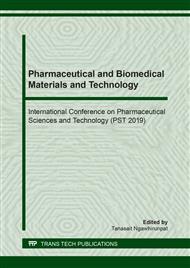p.85
p.92
p.98
p.104
p.111
p.118
p.124
p.130
p.139
Antioxidant, Antityrosinase Activity and Toxicity of Alpinia nigra Extracts
Abstract:
Excessive of ultraviolet light causes abnormality of melanin production. Antioxidants and antityrosinase agents are able to reduce hyperpigmentation by interrupting the process of melanin production. The purpose of this study is to examine the antioxidant and antityrosinase activities as well as toxicity of both 80% ethanol and aqueous extracts of Alpinia nigra by DPPH free radical scavenging assay, mushroom tyrosinase assay and brine shrimp lethality bioassay. Alpinia nigra extracts showed positive result on antioxidant and antityrosinase activities. We found that extract of A. nigra’s leaf has the most effective activity of antioxidant and antityrosinase among other parts of this plant. The ethanol and aqueous extracts from the leaf of A. nigra at the concentration of 125 μg/mL showed % inhibition for free radical scavenging as 94.97% and 93.35%, respectively. The IC50 values of antioxidant were 39.83±16.21 and 46.33±15.22 μg/mL, respectively. In addition, ethanol extract of the leaf from A. nigra at the concentration of 1,000 μg/mL produced 92.61% inhibition of mushroom tyrosinase activity, whereas aqueous extract of A. nigra’s leaf at the same concentration produced 74.47% inhibition. The IC50 of antityrosinase activities were 142.81±13.32 and 406.88±66.43 μg/mL for ethanol and aqueous extracts, respectively. Moreover, the brine shrimp lethality bioassay showed that all extracts were non-toxic (LC50 >1,000 μg/mL). In conclusion, the ethanol extract of A. nigra’s leaf may be beneficial and provide the novel and safe source for antioxidant and whitening agent.
Info:
Periodical:
Pages:
111-117
Citation:
Online since:
August 2019
Keywords:
Price:
Сopyright:
© 2019 Trans Tech Publications Ltd. All Rights Reserved
Share:
Citation:


